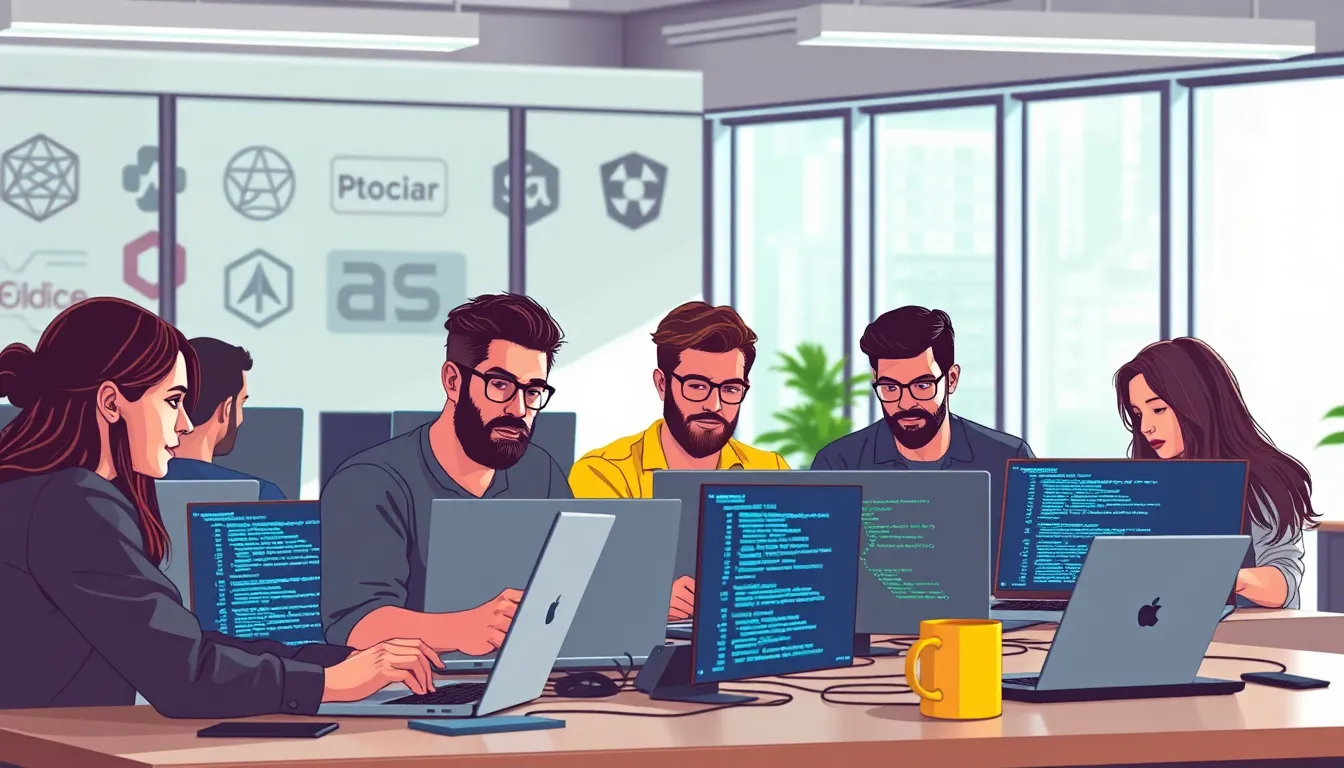In a world where cyber threats lurk around every digital corner, secure coding practices are the unsung heroes of software development. They’re like the trusty sidekick that always has your back, ensuring your code doesn’t turn into a hacker’s playground. Developers might think they’re just writing lines of code, but in reality, they’re crafting a fortress against potential breaches.
Imagine coding without a care, only to find out your application has more holes than Swiss cheese. Not exactly the legacy any developer wants to leave behind. By embracing secure coding practices, they not only protect their creations but also save themselves from sleepless nights worrying about data breaches. So, let’s dive into the essential strategies that’ll turn any coder into a security ninja, ready to fend off even the sneakiest of cyber villains.
Table of Contents
ToggleOverview Of Secure Coding Practices
Secure coding practices serve as essential tools in software development, providing significant defense against various cyber threats. Employing these strategies helps developers create robust applications that withstand potential breaches. Risks associated with insecure coding can lead to data leaks, financial loss, and reputational damage for organizations.
Implementing input validation is crucial to safeguard applications from harmful data attacks. By checking user inputs, developers can prevent exploit attempts such as SQL injection and cross-site scripting. Developing a strong authentication process reduces unauthorized access while increasing user data protection.
Utilizing secure coding frameworks simplifies adherence to best practices. These frameworks often include built-in security features that enhance application defenses. Regular updates to libraries and dependencies ensure that developers mitigate risks posed by known vulnerabilities.
Writing clear and maintainable code allows other developers to spot security flaws easily. Clear documentation paired with code comments fosters a collaborative environment focused on security. Developers significantly reduce the likelihood of security oversights when practicing these habits.
Adopting a threat modeling approach helps identify and prioritize potential vulnerabilities in the software’s architecture. By analyzing potential attack vectors, teams can focus their efforts on mitigating the most significant risks.
Collaboration among team members, including security experts, strengthens the overall security posture. Engaging in code reviews allows peers to examine and discuss potential weaknesses. Such shared responsibility promotes a culture of security within the development environment.
Continuous education around secure coding practices keeps teams informed about the latest threats and trends. By staying current with emerging best practices, developers enhance their skills and adapt to the evolving landscape of cybersecurity.
Common Vulnerabilities

Understanding common vulnerabilities is essential for developers aiming to implement secure coding practices. Awareness of these threats helps protect applications from potential exploits.
Buffer Overflows
Buffer overflows occur when data exceeds the boundaries of a buffer, causing adjacent memory locations to be overwritten. Attackers can manipulate this vulnerability to execute arbitrary code or crash the application. Prevention methods include using safe functions that limit input size and implementing bounds checking on all data received from external sources. Utilizing languages that manage memory automatically can further reduce the risk associated with buffer overflows.
SQL Injection
SQL injection vulnerabilities arise when an attacker injects malicious SQL statements into input fields, allowing unauthorized access to databases. This can lead to data breaches or data manipulation. Developers can mitigate this threat by employing prepared statements or parameterized queries. Input validation also plays a key role in ensuring that only expected and safe data is processed. Regular audits and updates of database access controls reinforce protections against SQL injection attacks.
Cross-Site Scripting (XSS)
Cross-Site Scripting (XSS) allows attackers to inject malicious scripts into webpages viewed by unsuspecting users. This can result in session hijacking, identity theft, or redirection to malicious sites. Developers can combat XSS threats by encoding user input and using Content Security Policy (CSP) headers. Regular code reviews help identify XSS vulnerabilities before deployment. Implementing sanitization techniques on output data ensures that harmful scripts cannot execute in a user’s browser.
Best Practices For Secure Coding
Secure coding practices play a vital role in mitigating vulnerabilities. Developers should prioritize implementing methods that safeguard applications against threats.
Input Validation
Input validation prevents harmful data from damaging an application. Developers must ensure that all user inputs undergo rigorous validation checks. Techniques include whitelisting acceptable input types and using regular expressions for pattern matching. Rejecting inputs that do not conform to established rules is essential. This proactive measure reduces the risk of attacks such as SQL injection and XSS by only allowing safe data to process within the application.
Error Handling
Effective error handling strengthens application security by preventing sensitive information leaks. Error messages should be generic, avoiding the exposure of system details. Designers must log severe errors securely without disclosing information to end users. By providing clear but non-informative responses, developers minimize the opportunity for attackers to exploit vulnerabilities. Regular audits of error handling processes can identify weaknesses, ensuring that error management aligns with security standards.
Code Reviews
Code reviews enhance security through collaborative scrutiny of code. Teams should conduct regular reviews to identify vulnerabilities missed during development. By involving security experts in the process, developers gain valuable insights into potential threats. This collaborative environment fosters a culture focused on security, making it easier to pinpoint areas for improvement. Establishing common review practices ensures that every line of code receives thorough evaluation, strengthening the overall security posture of the application.
Tools And Resources
Developers can leverage various tools and resources to enhance secure coding practices. These resources help identify vulnerabilities and improve code security effectively.
Static Analysis Tools
Static analysis tools analyze source code before execution. They identify potential vulnerabilities and enforce coding standards by checking code without runtime. Notable tools include SonarQube, which provides comprehensive code quality metrics, and Checkmarx, known for its ability to detect security flaws early in development. Additionally, Fortify Static Code Analyzer efficiently scans for compliance with security guidelines. By integrating these tools into the development lifecycle, teams can catch issues early, significantly reducing risks associated with vulnerabilities.
Dynamic Analysis Tools
Dynamic analysis tools assess running applications to expose security weaknesses during execution. Tools like OWASP ZAP provide automated vulnerability scanning for web applications, while Burp Suite specializes in penetration testing for identifying potential security weaknesses. Additionally, Veracode offers a cloud-based platform for application security testing, addressing both static and dynamic vulnerabilities. Utilizing these tools allows teams to simulate real-world attacks, ensuring applications withstand malicious attempts. By incorporating dynamic analysis into the development workflow, teams can effectively enhance the security of their code.
Embracing secure coding practices is essential for developers aiming to build robust applications. By prioritizing security from the outset, teams can significantly reduce the risk of vulnerabilities that may lead to costly breaches. Implementing strategies like input validation and strong authentication not only protects data but also fosters user trust.
Regular collaboration and education within development teams create a culture of security awareness. Utilizing advanced tools for static and dynamic analysis further enhances the ability to identify and mitigate risks early in the development process. As the cyber threat landscape continues to evolve, staying informed and proactive in secure coding will be key to safeguarding applications and maintaining organizational integrity.






